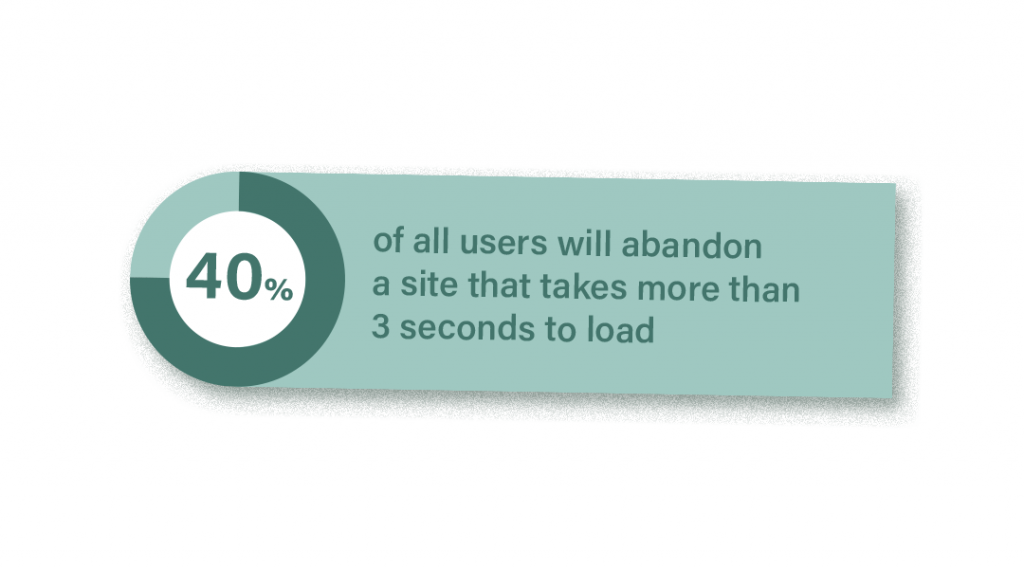
Next to providing quality content, website speed is an important factor when it comes to keeping users around. How fast you can deliver content can make or break a user’s decision to stay on your webpage. In fact, 40% of all users will abandon a site that takes longer than 3 seconds to load.
For many publishers, poorly implemented ads are the root cause of lackluster loading speeds. What’s meant to create a passive stream of income may actually be a traffic killer if not done well. Balancing website load speed with your ad-monetization strategy is the only way to get the best of both worlds: high-quality, consistent traffic, and soaring revenue.
How Ads Cause Slow Loading Speed
The most well-documented reason why ads lead to poor load speeds is that they increase page-weight. Page-weight refers to the size of all of a web page’s files that must be downloaded onto a user’s device for them to view said page. It includes everything from CSS and scripts to images, video, and content. It directly influences how fast a page will load when requested, and without proper optimization, ads weigh down page speed quite a bit.
Low-quality ads can also be a big factor in slowing everything down. These can occur when publishers work with lower-tiered ad networks that don’t keep their servers optimized. Be sure to only work with reputable and high-quality networks!
Solutions
The fewer content and design elements a website has, the faster the page loading speed–but that’s not a practical solution for good user experience or ad-revenue.
The solution?
To balance critical components of ad-monetization for high-yielding ads that don’t slow down website speed. Since poorly optimized ads, poor quality ad networks, and poor back-end maintenance are the biggest culprits of slow loading speed, we’ll discuss several solutions that target each.
Test Speeds
Ideally, you should be able to test your website loading speed once in a while. It’s the easiest way to identify and quickly work to resolve any issues. It’s also essential to test page-loading speed anytime a change is made to ad units (placements, sizing, etc.). Beware that not all speed tests are created equal, and some may be providing you false information.
Optimize Images
High-quality large image files are the biggest contributor to webpage size. Optimizing images is the best way to ensure they don’t negatively impact site speed. To optimize, publishers need to consider:
- Proper sizing: implementing fixed width and auto-height instructions trigger more responsive images.
- Format selection: For high-quality images with no modifications needed, use JPG. For images with icons, logos, and text, try using a PNG.
- Number of images: Don’t weigh your webpage down by having too many images. Keep your content balanced and don’t add extra elements if they aren’t necessary.
Limit Rich Media Ads
Rich media ads are those dynamic, in-your-face ads with video that basically scream ‘see me!” They’re meant to lead to higher engagement rates and, in some cases, can even outperform banner ads by as much as 267%. Sounds perfect, right? Unfortunately, this stellar performance can also come with a hefty burden on load speed. Depending on how quick your visitors’ internet speed is, there could cause issues, so be wary! That said, a good ad partner will ensure that rich media ads load asynchronously and lighten the load as much as possible.
Minimize JavaScript
Beyond making efforts to decrease page size, publishers should reduce the number of client-server requests in delivering website content to browsers. By keeping your javascript code attachments to a minimum, you can improve page load speed and user experience. Header bidding plays a key role here, since there is one bidding script for all ad units.

Utilize Caching
A cache is a type of memory used to increase the speed of data delivery. It delivers ‘cached’ copies of requested content instead of rendering it repeatedly to returning users. Publishers who cache their sites reap the benefit of providing faster loading time for returning users. WordPress offers various plugins for implementation, such as Quick Cache, WP Super Cache, and WP Fastest Cache.
Deploy Lazy Loading
You can try deploying lazy loading to increase page speed and boost ad impressions. Lazy loading works by supplementing placeholder content boxes onto a browser and replacing them with ads as the user scrolls them into view or a certain amount of time passes. While lazy loading has its benefits and risks, publishers who can implement it successfully will have a lot more to gain.
Note for current publishers: If you’d like to test out a lazy-load script, send a note to your publisher representative!
Upgrade To Header Bidding
Working with professionals is the most effective way to balance website loading speed and ad monetization. Header bidding is a programmatic technique in which a provider auctions ad units to an array of ad networks simultaneously. Since ads are our expertise, we’re able to offer a wide range of solutions for balancing page speed.
Our account managers will help you with each step of ad layout optimization. They’ll work with you to decide the best size, type, and location for each ad unit, creating high-value ads optimized for both the backend and user experience. Aside from using best practices as guidance, they’ll help to further improve ad placement based on a website’s insights and analytics.
Newor Media also provides asynchronous loading. In synchronous loading, scripts are loaded sequentially, and when one issue arises, the scripts to follow are unable to load. With asynchronous loading, scripts load simultaneously, meaning one won’t hold up the others.
Though it would seem that adding more networks would delay ad serving, we optimize on a bidder-level. This means more competition for your ads without negatively impacting ad rendering. We optimize timeouts and enable and disable bidders based on performance. Additionally, you’ll never have to worry about low-quality networks filling your ad spaces with malicious content, as we exhaustively vet each new network before they’re added to your stack!
Conclusion
There’s a fine line one must walk between maximizing ad revenue and site loading speed. Understanding the elements that directly play into the two is just the start of creating balance. Fortunately, you’re not alone! Take a few seconds to fill out our earnings calculator and see how much you could be making.

3 Comments
Comments are closed